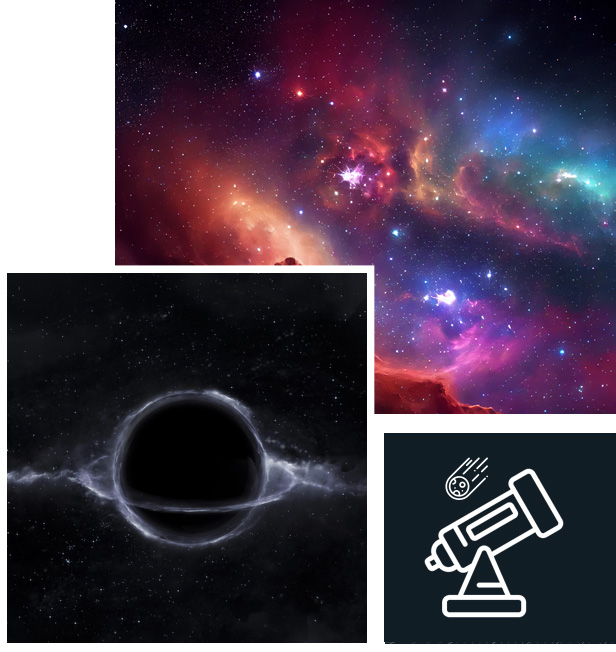
CENTRES OF EXCELLENCE
Centre for autonomous space monitoring
The main task of the project in the field of Astronomy is to adapt the scientific activities of the Prof. Janusz Gil Institute of Astronomy to the new demands of the constantly developing space industry, especially in terms of space security, i.e. to ensure the uninterrupted and faultless operation of satellite infrastructure by detecting and tracking so-called space junk – small objects (mainly inactive satellites and/or their fragments) orbiting the Earth.
Research Areas:
1. Optical space monitoring.
2. Search for extrasolar planets, small-mass black holes and monitor temporal phenomena detected by massive sky surveys.
RESEARCH AREA 1
Optical space monitoring.
Optical space monitoring is concerned with tracking space junk and geostationary satellites as well as asteroid populations that could threaten the Earth. Space junk is a big threat to satellites, terrestrial infrastructure as well as human life. To ensure the security of satellites, most of the world’s, including Europe’s, satellite operators rely exclusively on information provided by the USA.
The European Commission established the European Space Surveillance and Tracking (SST) Consortium – EU SST – in 2014 to provide an independent European service for monitoring and tracking artificial Earth satellites. Within the rapidly expanding satellite services space, American observation and tracking services will not be sufficient to ensure the security of the future satellite population. In addition to increasing the quantity and quality of sensors, it is also necessary to increase the capacity to process the increasing amount of data, as well as to introduce innovative techniques in this area.
In addition to space junk, asteroids whose orbits pass close to the Earth also pose a threat. Tracking such celestial bodies has been carried out for years by the Americans. In 2005, the USA Congress committed NASA to detecting at least 90% of near-Earth objects 140m or larger.
Currently, the European Space Agency (ESA) is conducting a study to develop infrastructure from which it will be able to acquire data on: space traffic management (STM -Space Traffic Management); prediction and tracking of objects in Earth’s orbit (SST – Space Surveillance and Tracking); observation of asteroids and, in particular, objects having orbits close to Earth’s orbit, so-called Near Earth Objects (NEOs). Our efforts are aimed at improving global security and the safety of satellite systems.
RESEARCH AREA 2
Search for extrasolar planets, small-mass black holes and monitor temporal phenomena detected by massive sky surveys.
Conducting fundamental research using Earth space monitoring stations, including, but not limited to, the search for extrasolar planets, small-mass black holes and monitoring of temporal phenomena detected by wide-area sky surveys (Gaia, ASAS-SN, ZTF, LSST). The task will be based on the study of stars indicated by satellites such as the Kepler Space Telescope, the TESS (Transiting Exoplanet Survey Satellite) Space Telescope or the Ariel Space Mission planned and under construction by ESA.
The main focus of this research is to look for extrasolar planets that are similar to the Earth, i.e. they are rocky and have the conditions necessary to maintain water in a liquid state. In addition, regular monitoring of cataclysmic stars will help solve the mystery of the existence of extrasolar planets in orbits around tight binary systems.
Also important will be research on the search for small-mass black holes with masses of a few solar masses that represent the missing link in the black hole family (massive and supermassive black holes are most abundant in the Universe).
The planned infrastructure will be used to monitor temporary phenomena such as gravitational microlensing phenomena, in which a dark and compact object – a black hole or neutron star – can be used as the lens. The optical telescope matrix is an excellent tool for such observations.
Unique equipments:
monitoring station equipped with an optical telescope with a mirror diameter of 700 mm with azimuthal mounting with direct-drive technology and sCMOS cameras.
The autonomous monitoring station will be placed in the Atacama Desert in Chile, where conditions are excellent for observation.
Owning a telescope of significant size will allow the University of Zielona Góra to join the ranks of universities conducting advanced research in astrophysics in the field of optical observations and space monitoring targeting objects in near-Earth orbits that may pose a threat to the Earth. It will also enable the establishment of cooperation with ESA, which will significantly advance the research conducted at the Institute of Astronomy in the field of optical observations.
